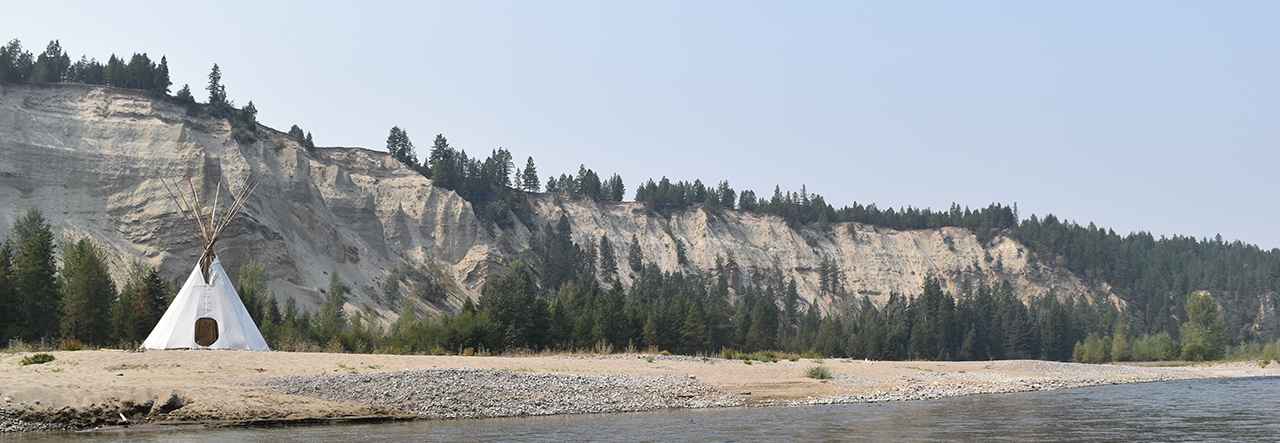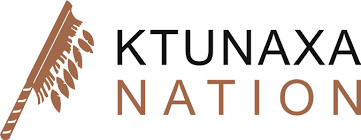The Ktunaxa people have been in this area since Naⱡmuqȼin fulfilled his prophecy and placed the Ktunaxa people in this area to be the keepers of the land. At that time there was some disturbance caused by a huge water monster known as Yawuʔnik̓, who killed many of the animals. It was decided that Yawuʔnik̓ had to be destroyed. A war party was formed. Yawuʔnik̓ plied wu·u ʔaqsⱡmaknik ʔakinmituk (Kootenay) and Miȼ̓qaqas (Columbia) River System. When Yawuʔnik̓ was killed, and butchered and distributed among the animals, Yawuʔnik̓’s ribs were scattered throughout the region that now form the Hoodoos seen throughout the region.
When the prophecy was fulfilled the spirit animals ascended above and are now the guiding spirits of the Ktunaxa. In all the excitement Naⱡmuqȼin rose to his feet and stood upright hitting his head on the ceiling of the sky. He knocked himself dead. His feet went northward and is today known as Ya·kⱡiki, in the Yellowhead Pass vicinity. Naⱡmuqȼin’s head is near Yellowstone Park in the State of Montana. His body forms the Rocky Mountains - http://www.ktunaxa.org/who-we-are/creation-story/.
Long before James Baker an English settler and Colonel Sam Steele, of the Northwest Police arrived in the Kootenay’s, the Ktunaxa people enjoyed ʔakisqakⱡiʔit without interference. ʔakisqakⱡiʔit was one of the many chosen farms and vacation sites Ktunaxa lived at different times of the year. It was free of mosquitos, had freshwater creeks and grazing for horses and other farm animals. The chief of the community was Chief Joseph who set up his home with a garden and horses that roamed freely throughout ʔakisqakⱡiʔit.
Before the settlers came the Ktunaxa and Ksanka, our people who are in what is now Montana, had attended a meeting with the Flathead and Pend O’Reille tribes in the southern Montana at a place called Council Grove Sacred Heart of Mary - Maⱡi Akiⱡwiy. The Blackrobe, who were the first group sent by the Queen to travel North America, told the ʔakⱡsmaknik (Red People) that “the white people were spilling into the country and taking up land. And, if they did not take up land that they would be chased into the mountains.” So, that is when the Ktunaxa/Ksanka group chose to move up to the northern part of their homeland.
The Ktunaxa knew there would be a large amounts of white people arriving to Ktunaxa ʔamakʔis (land) and knew things would change.
The change affected the land. The Kootenay Land District were open to land settlement pre – emptions in 1868. As settlers made land purchases one parcel of land in particular, ʔakisqakⱡiʔit also referred to as Joseph’s prairie land, became an issue.
ʔakisqakⱡiʔit, Joseph’s Prairie, the area that was travelled and use by Ktunaxa before the coming of the white settlers, had been purchased and worked by a settler, Galbraith who eventually sold it to James Baker. Galbraith had an agreement with Chief Joseph which was the Ktunaxa could continue to use the land for their needs. However, Baker rejected the arrangement between Galbraith and the Chief Joseph. Chief Isadore, who was Chief Joseph's step son who was handed the chieftainship to, were now forbidden to farm the land that was left to him by his stepfather Chief Joseph. Ktunaxa knowledge says that the issue became contentious when their homes and other implements were burned to the ground three times to force the Chief and his family from his land. This caused tension between Ktunaxa and settlers.
In 1884 two miners were found dead at Deadman’s Creek without leads to charge anyone for the murders, the Ktunaxa were under suspicion where two Ktunaxa men were arrested, Kapⱡa and Little Isadore being placed in a holding cell at Fort Steele. Colonel Sam Steele of the North West Mounted Police and his troupe were called in from Alberta to manage the growing discontent.
After many days of meetings with the Ktunaxa, Colonel Sam Steele and an Indian Reserve Commissioner who had been called in, a settlement was reached. Chief Isadore was able to take care of the matter of the two men and he accepted other Indian Reserve land in lieu of ʔakisqakⱡiʔit, Josephs’ Prairie.
 Cranbook
Cranbook



